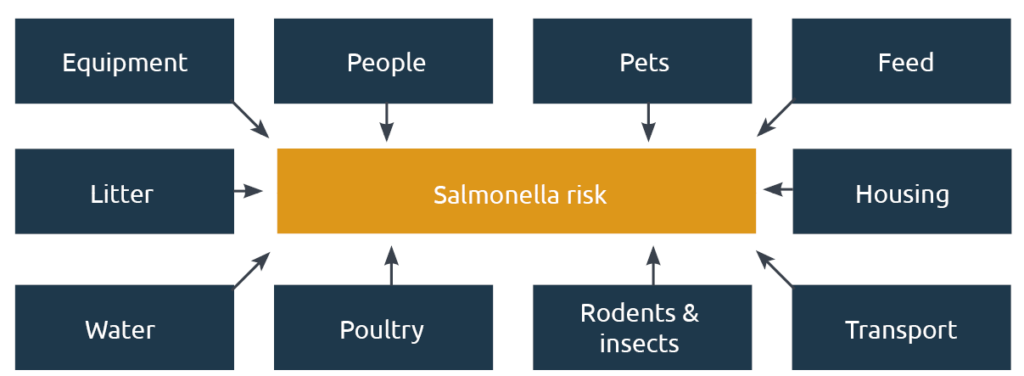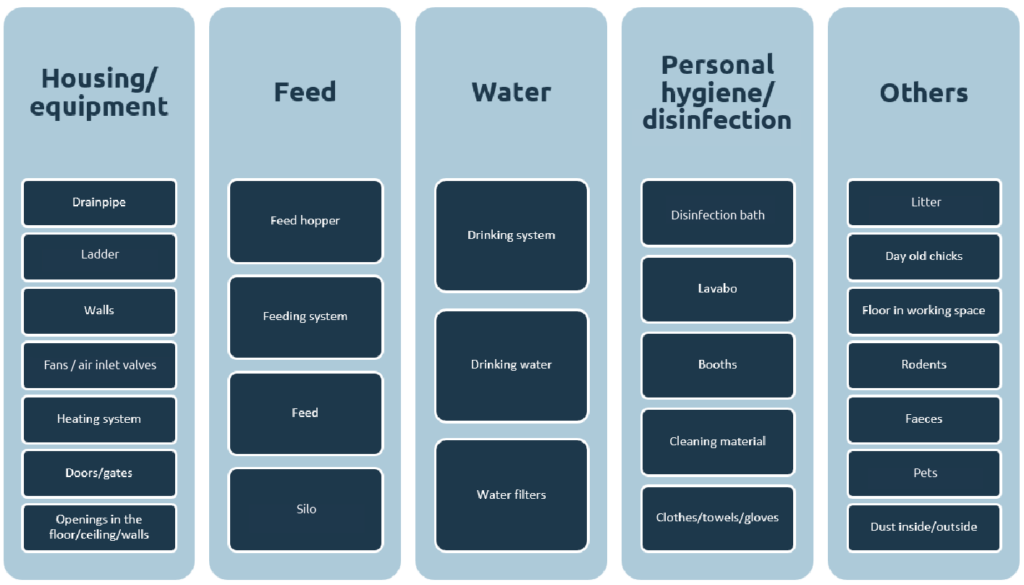Written by Jan Vervloesem, Global lead poultry at Agrifirm
Salmonellosis is still one of the main zoonosis worldwide. In Europe alone, more than 60,000 cases are officially recorded, and the actual number is likely much higher. In order to reduce the risk on Salmonellosis the EU has implemented several legislations, also for poultry production, describing measurements to be taken to monitor the incidence. This is to reduce the presence in the environment and to reduce the risk of transmitting salmonella to humans. A significant part of prevention is the responsibility of consumers, who must handle, store, and prepare food hygienically.
Very often poultry meat and eggs are blamed for being the source of contamination. But is this the real cause? In the poultry meat and egg production chain the reason why poultry becomes positive for salmonella can be diverse from flock to flock, from animal to animal.
To reduce the incidence of salmonellosis caused by poultry meat or eggs, it is important to monitor the major pathogenic serotypes. This monitoring needs to occur in the environment and in the flock before, during and after the production process. Next to that identifying and determining the risk is necessary in order to prioritize and focus on the proper issues. Nothing should be excluded as both horizontal and vertical transmission is possible (figure 1).

It is obvious that controlling salmonella in poultry meat and eggs starts with salmonella free day old chicks and with a salmonella free poultry house. To achieve this stringent biosecurity programs adapted to your specific circumstances and monitoring programs can be developed in order to reduce the risk (figure 2). Monitoring involves checking everything inside or entering the poultry house for the presence of salmonella. However, the risk will never be zero because salmonella is a bacterium that can survive harsh conditions for a long time, and even brief negligence can cause a problem.
Poultry is more susceptible to salmonella contamination in the first week after hatching than when it is mature. Of course stress reduces the functioning of the immune system and makes the animal more sensitive and less resistant to salmonella contamination. What is generally observed in flocks which are positive for salmonella is that not 100% of the animals are positive, but more likely 3 to 10%. The real risk for salmonellosis are the 3 to 10% of the animals in the flocks. This is what the industry needs to focus on as a strategy to further reduce the incidence of salmonellosis and improve the image of poultry being the main reason for human salmonellosis. Preventing horizontal transmission between poultry in the poultry house is key in order to reduce the risk on salmonellosis.

How can this be achieved? One broiler or hen does not contaminate another one just by standing next to each other but the main reason for spreading salmonella in a poultry house are the excreta of the positive birds.
MCFAs in S-prove and how it works
Some Medium Chain Fatty Acids (MCFAs) have a strong effect against salmonella. Especially in an acidified environment. For this reason they are essential in controlling salmonella in the animal itself. In the gizzard, having a pH of +/- 3,5 , MCFAs remain 100% undissociated resulting in maximum antibacterial activity. S-prove, based on these MCFAs, is able to kill close to 100% of the salmonella by entering the bacteria via the membrane and then acidify them from the inside. In doing so, less salmonella bacteria are able to enter into the small intestine in order to duplicate, colonize and contaminate the animal. Still, some might do. It is important that products used to reduce the incidence of salmonella not only kill the bacteria but also prevent their duplication and reduce their virulence and invasiveness. Beside the killing effect S-prove is able to block duplication of Salmonella by intercalation with the DNA of the bacteria. This reduces the adherence of salmonella to epithelial cells and additionally S-Prove reduces the virulence and invasiveness significantly. This not only by its direct effect on the bacteria itself but also by the positive effect on the intestinal morphology and the increased capacity to secrete mucus. Besides these effects there is the additional effect on the innate immune system by stimulating the secretion of avian β-defensin-9 which is known to have explicit activity against salmonella. MCFAs are also known to reduce the H/L-ration, a biological marker as an indication that the animals are less stressed and less susceptible to salmonella contamination.
Research data have shown that for instance in comparison with butyric acid, which is also known to kill and reduce the invasiveness of salmonella, S-prove is significantly more efficient in reducing the risk on salmonella contamination (table 1).
Table 1: The effect of S-prove on the virtual risk on salmonella contamination based on in vitro and in vivo trial (Nutrition Sciences).
| Butyric acid (0.03%) | S-prove (0.03%) | |
|---|---|---|
| % kill off | 70.0 | 97.64 |
| % survive | 30.0 | 2.36 |
| Invasion efficiency % | 4.35 | 1.69 |
| Virtual risk on contamination % | 1.31 | 0.04 |
Conclusion
Besides this specific effect on salmonella, S-prove also contributes to an improved performance through an improved FCR, an improved daily weight gain and a reduced mortality. This additional effect, next to reducing the risk on salmonellosis, makes S-prove an economic product to improve food safety.